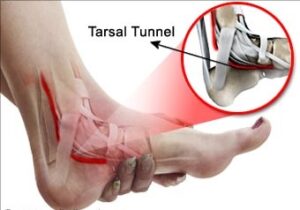 Tarsal tunnel syndrome is the compression due to irritation or damage of a crucial nerve that runs from your ankle to the foot. The condition develops after overusing your feet, straining the ankle, or developing diabetes or arthritis. Since tarsal tunnel syndrome is irritation or damage you need to be gentle with yourself, particularly, when taking on tarsal tunnel exercises. It is best to try conservative methods, but once they fail, a podiatrist may suggest tarsal tunnel release through tarsal tunnel syndrome surgery.
Tarsal tunnel syndrome is the compression due to irritation or damage of a crucial nerve that runs from your ankle to the foot. The condition develops after overusing your feet, straining the ankle, or developing diabetes or arthritis. Since tarsal tunnel syndrome is irritation or damage you need to be gentle with yourself, particularly, when taking on tarsal tunnel exercises. It is best to try conservative methods, but once they fail, a podiatrist may suggest tarsal tunnel release through tarsal tunnel syndrome surgery.
The tarsal tunnel is located near the heel and travels into the sole. The causes from compression to the tunnel include swelling through an ankle injury, fallen arches, diseases, or bone spurs. However, plantar fasciitis is the inflammation of the plantar fascia that causes severe stabbing pain. The pain from plantar fasciitis is usually worse in the morning with the first steps you take and the pain is less during the day unless you have long periods of sitting or standing.
Both of the conditions are diagnosed through general physical examination and history. Testing on the location of the pain determines which of the two conditions is present. For tarsal tunnel syndrome, the pain is described as tingling or burning just below the ankle bone however the tingling extends to the arch, heel, or toes. For plantar fasciitis, the pain is located along the bottom of the foot and is described as a stabbing pain particularly, early in the morning as you take the first steps or during intense activity. In both cases, the area of tenderness is determined to assist with diagnosis.
In both cases, the same conservative treatment options can be used. Medications to treat inflammation and over-the-counter pain relievers can be the first treatment reaction. The second step would be a steroid injection and the use of orthotics, splint, or brace.
Surgical interventions
When conservative treatments fail, surgical interventions are recommended but limited to several patients with persistent pain that interferes with daily functions. A patient should devote 6-12 months to conservative treatments before surgery is an option.
Tarsal tunnel release – The surgical treatment involves a small opening made behind the ankle down to the arch. Through the opening, the surgeon repositions the ligaments to release pressure put on the tibial nerve.
Plantar fasciitis – The surgical intervention involves detaching the plantar fascia from the heel bone. The procedure is done under local anesthesia where a small incision is made. Sometimes it is done under general anesthesia where a larger incision is made. The latter approach requires a longer recovery time through which the affected foot cannot bear the full weight of the body.
If you have any questions, please feel free to contact our office located in Houston, TX. Our Houston foot specialist can handle all of your foot and ankle issues. We will provide you with the latest diagnostic and treatment methods for treating all foot-related stress fractures